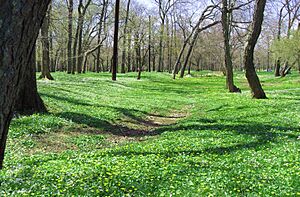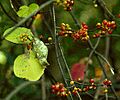List of invasive plant species in New Jersey facts for kids

Imagine plants that are like bullies in a schoolyard. They come from somewhere else and push out the plants that naturally belong there. In New Jersey, many plants have been brought in over the last 400 years. Some of these have become "invasive species". This means they spread quickly and harm the local environment. They compete with native plants for sunlight, water, and nutrients. This can make it hard for the original plants to grow and thrive.
A place called Duke Farms has found 55 different invasive plant species on its land. They are working hard to find ways to control these plants. It's a big job to protect New Jersey's natural plant life!
Contents
What are Invasive Plants?
Invasive plants are species that are not native to an area. They are introduced, often by humans, and then cause harm to the environment. They can also harm human health or the economy. These plants grow very fast and spread easily. They often don't have natural enemies, like insects or diseases, in their new home. This gives them a big advantage over native plants.
Why are Invasive Plants a Problem?
When invasive plants take over, they can change the entire ecosystem.
- They reduce the number of native plants. This means less food and shelter for native animals.
- They can change the soil or water conditions. This makes it even harder for native species to survive.
- Some invasive plants can even increase the risk of wildfires. Others might cause erosion.
- They can also be very expensive to control and remove.
Common Invasive Plants in New Jersey
Many different types of plants have become invasive in New Jersey. Here are a few examples of these plant "invaders":
Norway Maple
The Norway maple (Acer platanoides) is a popular tree. It was brought to North America from Europe. It grows very well in many different conditions. This tree produces many seeds that spread easily. Its dense leaves create a lot of shade. This shade stops native plants from growing underneath it. It can quickly take over forests and parks.
Tree of Heaven
The tree of heaven (Ailanthus altissima) came from China. It grows incredibly fast. It can sprout up almost anywhere, even in cracks in sidewalks. This tree releases chemicals into the soil. These chemicals stop other plants from growing nearby. It also has very strong roots that can damage buildings.
Garlic Mustard
Garlic mustard (Alliaria petiolata) is a plant from Europe. It spreads very quickly in forests. It grows early in the spring, before many native plants. This gives it a head start in soaking up sunlight and nutrients. It also changes the soil chemistry. This makes it harder for native tree seedlings to grow.
Japanese Honeysuckle
Japanese honeysuckle (Lonicera japonica) is a vine from East Asia. It grows very fast and can climb over other plants. It forms thick mats that block sunlight. This smothers and kills native trees and shrubs. It can also spread along the ground, covering large areas.
Purple Loosestrife
Purple loosestrife (Lythrum salicaria) is a beautiful plant with purple flowers. It came from Europe and Asia. It loves wet areas like marshes and wetlands. It forms dense stands that push out native wetland plants. This harms the animals that depend on those native plants for food and shelter.
Japanese Stiltgrass
Japanese stiltgrass (Microstegium vimineum) is a grass from Asia. It grows well in shady, disturbed areas. It forms thick carpets on the forest floor. This stops native wildflowers and tree seedlings from growing. It can spread very quickly, especially after floods or disturbances.
Asian Knotweed
Asian knotweed (Reynoutria japonica), also known as Japanese knotweed, is a very tough plant. It came from East Asia. It has strong, hollow stems and grows very tall. Its roots spread far and deep. It can even grow through concrete and foundations. It forms dense patches that block out all other plants.
Controlling Invasive Plants
Controlling invasive plants is a big challenge. It often involves different methods:
- Pulling them out: For smaller plants, people can pull them out by hand.
- Cutting them down: Larger plants or vines can be cut back repeatedly.
- Using chemicals: Sometimes, special chemicals are used to kill invasive plants. This must be done carefully to avoid harming native plants.
- Biological control: Scientists sometimes introduce natural enemies, like specific insects, to control invasive plants. This is done only after careful study.
Learning about invasive plants helps us protect our natural world. By understanding the problem, we can all help keep New Jersey's ecosystems healthy.
See also
- Invasive species in the United States
Images for kids
























